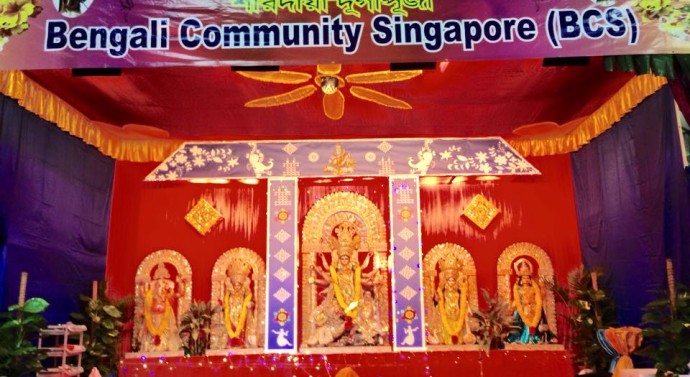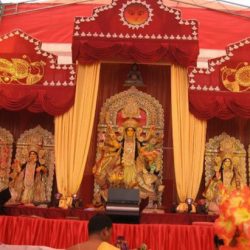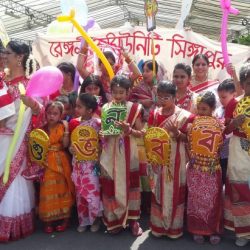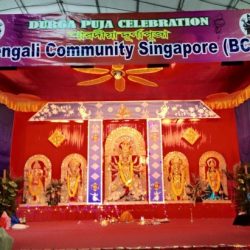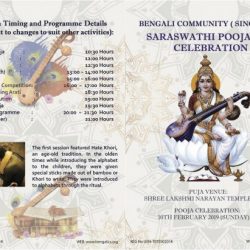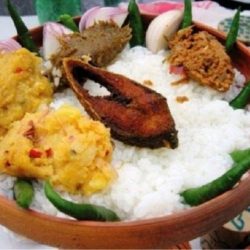Brief Information
SALUTATIONS to the Divine Mother, Durga, who exists in all beings in the form of intelligence, mercy, beauty, who is the consort of Lord Shiva, who creates, sustains and destroys the universe.
This festival is observed twice a year, once in the month of Chaitra and then in Aswin. It lasts for nine days in honor of the nine manifestations of Durga. During Navaratri (the word literally means “nine nights“) devotees of Durga observe a fast. Brahmins are fed and prayers are offered for the protection of health and property.
Durga Puja is the greatest Hindu festival in which God is adored as Mother. Hinduism is the only religion in the world which has emphasized to such an extent the motherhood of God. One’s relationship with one’s mother is the dearest and the sweetest of all human relations. Hence, it is proper to look upon God as mother.
Evolution of the Community or Sarbajanin puja
Initially the Puja was organized by affluent families since they had the money to organize the festival. During the late 19th and early 20th century, a burgeoning middle class, primarily in Kolkata, wished to observe the Puja. They created the Community or Sarbojanin Pujas, in which anybody, irrespective of caste, creed and religion, could participate in the festivities. This was consciously done to instill a feeling of unity.
These Pujas are organized by a committee which represents a locality or neighborhood. They collect funds called “Chanda” through door-to-door subscriptions, lotteries, concerts etc. These funds are pooled and used for the expenses of pandal construction, idol construction, ceremonies etc. The balance of the fund is generally donated to a charitable cause, as decided by the committee. Corporate sponsorships of the Pujas have gained momentum since the late 1990s. Major Pujas in metro areas such now derive almost all of their funds from corporate sponsorships. Community fund drives have become a formality. Despite the resources used to organize a Puja, entry of visitors into the Pandal is generally free. Pujas in major Cities and elsewhere experiment with innovative concepts every year. Communities have created prizes for Best Pandal, Best Puja, and other categories.
Akalbodhan
The worship of Devi Durga in the month of Ashwin is called ‘Akalbodhan‘- an uncustomary time for commencement of the worship. It is so called since the period of this worship differs from the conventional period (During the spring – ‘Basanta’). Ramayana says that when Rama was engaged in the fierce battle with Ravana, he wanted to secure the blessings of victory from Devi Durga. He held the puja to evoke the goddess during autumn to his dire plight, thereby worshiping Durga Untimely (In Akal). Hence this puja is called Akalbodhon.
It was customary to worship Durga with 100 Neel Kamals (Blue Lotuses). Rama could gather only 99 of them; he offered one of his eyes as a substitute of the 100th lotus.
Pleased with his devotion Durga blessed him. The battle started on Shaptami and Ravana was killed at the Shandhikshan (In between) Ashtami and Navami; he was cremated on Dashami. Therefore the four days of the puja that we celebrate ends in the triumph of the good over evil.
Creation of the idols
The entire process of creation of the idols from the collection of clay to the ornamentation is a holy process, supervised by rites and other rituals. On the Hindu date of Akshaya Tritiya when the Ratha Yatra is held, clay for the idols is collected from the banks of a river, preferably the Ganges. After the required rites, the clay is transported from which the idols are fashioned. An important event is ‘Chakkhu Daan‘, literally donation of the eyes. Starting with Devi Durga, the eyes of the idols are painted on Mahalaya or the first day of the Pujas. Before painting on the eyes, the artisans fast for a day and eat only vegetarian food. Many Pujas in and around the world buy their idols from Kumartuli (Kolkata, India), an artisans’ town in north Kolkata (West Bengal, India).
Puja Celebration& Rituals
The beginning of summer and the beginning of winter are two very important junctions of climatic and solar influence. These two periods are taken as sacred opportunities for the worship of the Divine Mother. They are indicated respectively by the Rama-Navaratri in Chaitra (April-May) and the Durga Navaratri in Aswin (September-October). The bodies and minds of people undergo a considerable change on account of the changes in Nature. Sri Ram Chandra worshipped Mother Durga during Navaratri.
The Durga Puja is celebrated in various parts of the world in different styles. But the one basic aim of this celebration is to propitiate Shakti, the Goddess in Her aspect as Power, to bestow upon man all wealth, auspiciousness, prosperity, knowledge (both sacred and secular), and all other potent powers. Whatever is the particular or special request that everyone may put before the Goddess, whatever blessing may be asked of her, and the one thing behind all these is propitiation, worship and linking oneself with her. There is no other aim. This is being effected consciously or unconsciously. Everyone is blessed with her loving mercy and is protected by her.
Durga Puja or Navaratri commences on the first and ends on the tenth day of the bright half of Aswin (September-October). It is held in commemoration of the victory of Durga over Mahishasura, the buffalo-headed demon. In Bengal her image is worshipped for nine days and then cast into water. The tenth day is called Vijaya Dasami or Dussera (the “tenth day”). Processions with Her image are taken out along the streets of villages and cities.
The mother of Durga (that is, the wife of the King of the Himalayas) longed to see her daughter. Durga was permitted by Lord Shiva to visit her beloved mother only for nine days in the year. The festival of Durga Puja marks this brief visit and ends with the Vijaya Dasami day, when Goddess Durga leaves for her return to Mount Kailas. This is the view of some devotees.
In Bengal, Durga Puja is a great festival. All who live away from home return during the Puja days. Mothers reunite with their sons and daughters, and wives with their husbands.
The potter shows his skill in making images, the painter in drawing pictures, the songster in playing on his instrument, and the priest in reciting the sacred books. The Bengalis save money throughout the year only to spend everything during the Puja days. Cloth is freely distributed to the Brahmins.
The woman of Bengal welcomes the Goddess with a mother’s love and sends away the image on the last day, with every ceremony associated with a daughter’s departure to her husband’s home and with motherly tears in her eyes. This signifies the parting of Durga from Her beloved mother.
Mercy of the Devine Mother
Durga represents the Divine Mother. She is the energy aspect of the Lord. Without Durga, Shiva has no expression and without Shiva, Durga has no existence. Shiva is the soul of Durga; Durga is identical with Shiva. Lord Shiva is only the silent witness. He is motionless, absolutely changeless. He is not affected by the cosmic play. It is Durga who does everything.
Shakti is the omnipotent power of the Lord, or the Cosmic Energy. The Divine Mother is represented as having ten different weapons in her hands. She sits on a lion. She keeps up the play of the Lord through the three attributes of Nature, namely, Sattwa, Rajas and Tamas. Knowledge, peace, lust, anger, greed, egoism and pride, are all her forms.
Truly speaking, all beings in the universe are Shakti-worshippers, whether they are aware of it or not, for there is no one who does not love and long for power in some form or other. Physicists and scientists have now proved that everything is pure, imperishable energy. This energy is only a form of divine Shakti which exists in every form.
A child is more familiar with the mother than with the father, because the mother is very kind, loving, tender and affectionate and looks after the needs of the child. In the spiritual field also, the aspirant or the devotee–the spiritual child–has an intimate relationship with the Mother Durga, more than with the Father Shiva. Therefore, it behaves the aspirant to approach the Mother first, who then introduces her spiritual child to the Father for his illumination.
The Mother’s Grace is boundless. Her mercy is illimitable; her knowledge infinite; her power immeasurable; her glory ineffable; and her splendor indescribable. She gives you material prosperity as well as spiritual freedom.
Approach her with an open heart. Lay bare your heart to her with frankness and humility. Be as simple as a child. Kill ruthlessly the enemies of egoism, cunningness, selfishness and crookedness. Make a total, unreserved, and ungrudging self-surrender to her. Sing her praise. Repeat Her Name. Worship her with faith and unflinching devotion. Perform special worship on the Navaratri days. Navaratri is the most suitable occasion for doing intense spiritual practices.
These nine days are very sacred to the Divine Mother. Plunge yourself in her worship. Practice intense repetition of the Divine Name, having a regular “quota” of repetitions per day, and the number of hours spent on it.
Glory to the Divine Mother! Let her take you, step by step to the top of the spiritual ladder and unite you with the Lord!
–
Uttom Kumar Nag
Honorary Secretary
